Prologue
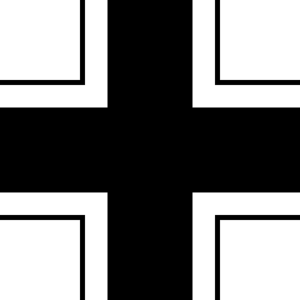
Throughout a large portion of the 20th century, the photographic industry was heavily tied to Germany. In addition to cameras and lenses, Germany was also tied to a whole list of atrocities committed by it’s government and the Nazi regime.
This is a topic that is very sensitive to a lot of people, and sadly, has recently become more of a conversation topic among extremist groups in the United States and other countries.
My passion for collecting cameras is heavily rooted in their histories. I enjoy researching the stories behind the people who created and used these wonderful devices, and considering a camera’s entire purpose is to capture moments on film, being able to wonder about the things these cameras have seen is really exciting for me.
In July 2018, I was contacted by a reader of this site named Joe Prah saying he had a military Leica and wanted my help to authenticate it. After getting some pretty convincing, but low resolution images, I asked around for help in authenticating it, and nearly every response told me I needed to consult with one man. That man was Leica historian, author, and war-time expert Jim Lager. I found Jim’s contact information online, sent him the pics and asked for his help. From there, the seeds for this article were planted.
I am a camera history enthusiast. Although the link between Nazi Germany and Leica cameras is real, this article is about the history of the camera, and nothing more. For anyone misguided enough to even remotely consider anything Nazi Germany did back then as a good idea, this article is not for you. If however, you are interested in a fascinating period of history, that just happens to coincide with some dark times, then please keep reading and I hope you find it as interesting as I have.
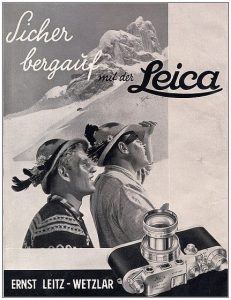
Intro
The Leica camera has an undeniable link to Nazi Germany, but it’s president, Ernst Leitz II was not a willing supporter of the regime. In the years prior to the war, Leitz secretly helped train and promote Jewish workers from his factory in the city of Wetzlar into sales positions, so they may be sent on sales trips to New York, and other western countries, freeing them from future atrocities. Leitz’s so called “Leica Freedom Train” isn’t nearly as well known as the efforts by Oskar Schindler, but is no less significant.
Over the years, collectors have been aware of so called Luftwaffe (air force) Leicas, and although a great deal of these cameras were made for the German air force, they were not exclusively produced for just one branch of the Wehrmacht. There exist cameras shipped to the Heer (army) and Kriegsmarine (navy) as well, but overwhelmingly, the majority went to the Luftwaffe.
Leitz has a long history of detailed record keeping, and throughout this period of their history, each serial number was tracked in ledgers detailing shipment numbers, dates, and (usually) destinations. Although produced in Wetzlar, many cameras left the factory and went straight to agents in Berlin. It was through this documentation kept by Leitz that today we are able to validate a large number, but not all Wehrmacht Leicas. For reasons that we will likely never know, only cameras shipped to the Luftwaffe have detailed records. In addition, later entries from 1943 and 1944 are more erratic and sloppy, perhaps due to disorganization and duress Leitz employees likely suffered near the end of the war, so even with the incredible detail of these records, not every Wehrmacht Leica can be fully verified.
Jim Lager was gracious enough to provide me with a copy of his book, “Wehrmacht Leica” which contains a great deal of information that he has compiled through over 40 years of research and study into the history of the Leica camera. Although Lager’s book is not complete, it is without a doubt the reference article for anyone wanting to verify the authenticity of a genuine war time Leica.
Validating the authenticity of a wartime product made by a country that lost the war is incredibly difficult. We’ll never know an exact number of how many of these cameras were shipped, let alone how many were destroyed during the war.
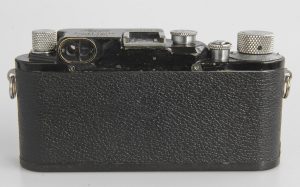
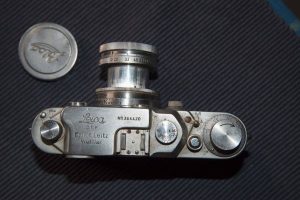
In addition to these challenges, of the examples that survived, many have been defaced to hide their identities. Although there is a large amount of interest today in the history of wartime products, for many Germans after the war, the Nazi regime was a disgrace and source of embarrassment. Leica cameras were still desirable after the war, but any featuring logos or engravings indicating their war-time use were often scraped away, hiding their identities.
Identifying Soviet fakes is usually pretty easy because they are often adorned with egregious design details such as “Berlin 1936” inscriptions, Iron Cross logos, Nazi swastikas and other ornamental decorations that the real things never had. Strangely, many Soviet fakes are stripped of the original chrome plating and left to either a bare or polished brass finish. Some are painted awful colors like bright red, blue, or orange, or even skinned in faux wood or other body coverings, none of which were ever done to the real things.
Even without the ridiculous ornaments, FED and Zorki rangefinders were based off the Leica II and do not have the slow speed dial on the front. All Wehrmacht Leicas were based off the Leica III, so without that dial on the front, the likelihood of a fake is very high. There are several other, less obvious physical characteristics such as the trim around the rangefinder window, and the shape of the metal next to the accessory shoe that the Soviet cameras have that are different from the real thing. For more information on identifying fake Leicas, Rick Oleson has a good source of information that identifies a variety of things to look for.
For the more authentic fakes like those made from other Leicas, the best way to identify a fake is by looking for characteristics that were known to exist on other identical ones. Serial numbers are often hard to fake as you need to get the exact number of an actual Wehrmacht Leica from the Leitz ledgers and make sure it is the correct type and with the correct markings.
I mentioned earlier that Leicas were shipped to all three branches of the German Armed Forces, but since a majority of them were sent to the Luftwaffe, and those are also the ones with the best records, these will be the cameras I focus mostly on throughout this article.
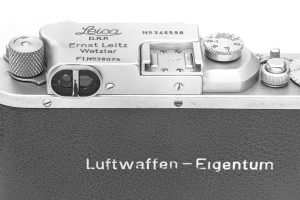
Luftwaffe Leicas
Entries exist in Leitz ledgers from 1939 through 1944 for the Luftwaffe. Luftwaffe Leicas were created out of five different models, the Leica III, IIIa, IIIb IIIc and IIIcK. Getting an exact number of how many were shipped is impossible, but here are the estimations of how many were shipped and how many are known to still exist today:
- Between August and November 1939, around 75 total III and IIIa models were shipped starting with serial number 338476. Of these 75, only 10 have been known to survive, making these the rarest of the Luftwaffe Leicas
- Between November 1939 and June 1940, around 446 IIIb models were shipped starting with serial number 344176. Of those 446, a very large single shipment of 300 was completed in February 1940. Of these 446, less than 50 are known to survive.
- Between May 1940 and August 1944, slightly less than 3100 IIIc and IIIcK models were shipped starting with serial number 362101, making these the most common of Luftwaffe Leicas.
Germany famously attacked Britain in July 1940 using Luftwaffe fighters and bombers and it can be assumed that many of the early III and IIIb models were on board those aircraft during those period suggesting that probably a large number of them were lost during this time.
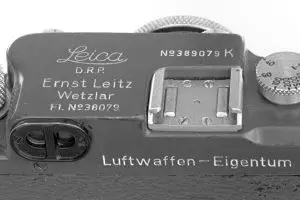
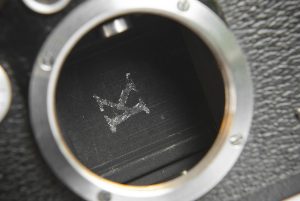
During production of the IIIc cameras, the IIIcK models were produced. The inclusion of the “K” at the end of the serial number indicates the camera has a Kugelager (ball bearing) shutter. Most IIIcKs have the letter “K” stamped on the inside of the actual shutter (seen with the lens removed in the image to the right) curtain with the letter “K” on it. The IIIcK models first shipped in February 1942 and were chrome plated. Gray painted IIIcK models appeared later.
It’s worth noting that the order in which cameras were shipped did not necessarily follow the serial numbers. There were examples of lower serial numbers that were shipped after ones with higher numbers. A good example is that although the last Luftwaffe Leica to be shipped was in August 1944, this batch’s serial numbers were 385600-385800 and the highest numbered Luftwaffe Leica was 391254, shipped earlier that year in March.
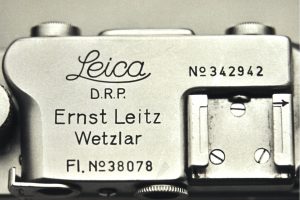
Identifying a genuine Luftwaffe Leica requires one of three things to be true. For one, it must have a serial number that is within the known range of Luftwaffe Leicas, but it should also have an engraving the top plate immediately below “Ernst Leitz Wetzlar” that says either Fl. No38078 or 38079. Only the earliest pre-IIIc Leicas have No38078, but this number is not found on IIIc and IIIcK models.
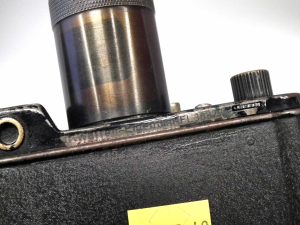
The letter’s “Fl” most certainly mean “Flieger” which loosely translates to “Flyer” and was used as an inventory number for different products used by the Luftwaffe. There exist many other goods with Flieger numbers, such as Berning Robot cameras (Fl. No38077), Schneider loupes (Fl. No38028), Leitz enlargers (Fl. No38112), Flight helmets (Fl. No31216 and 31217), and a filmstrip projector (Fl. No140175).
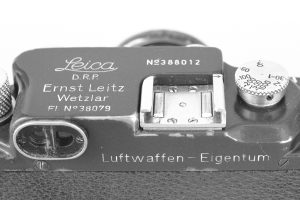
The last thing that nearly all Luftwaffe Leicas have is an inscription that says “Luftwaffen-Eigentum” which means “air force property”. On all Leica III, IIIa, IIIb, and some early IIIc models, the inscription is embossed and paint filled on the rear of the camera. At some point during the shipment of the model IIIc, this was changed to an engraving on the rear of the top plate, to the right of the viewfinder eyepiece.
One problem with identifying these cameras was that after the war, many of these inscriptions were scratched out, covered up, or otherwise defaced to hide the history of the camera. As much as the people who would have done this wanted to forget the horrors of the war, Leica cameras were still desirable, so it made no sense to simply throw away the camera. It is possible to have an actual Luftaffe Leica and not see any of these inscriptions, yet it would still be considered a Luftwaffe Leica.
Although the inclusion of a known matching serial number, correct Flieger number, and “Luftwaffen-Eigentum” inscription are requirements to validate a true Luftwaffe Leica, in recent years, counterfeiters have gotten better at mimicking these marks to create fakes. Looking for inconsistencies in the engraving is a good, but not fool proof method to identify genuine cameras as the typeface used in the inscriptions varied on the real thing.
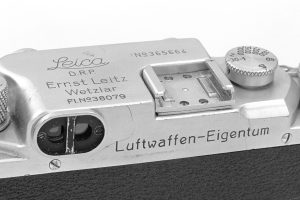
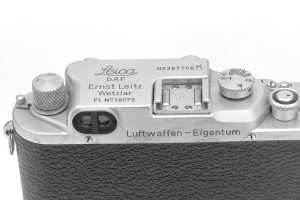
There are known differences in the typeface used in the Flieger number, most noticeably on the numbers 7 and 9. Most of the 7s have a straight diagonal leg, but some have a hooked leg. For the 9s, some are quite a bit fatter than the others. Even the “Luftwaffen-Eigentum” engraving has been known to look different on genuine cameras. On most cameras, the lowercase letters ‘a’ and ‘e’ are angular and the ‘w’ has a hook in the upper right corner, yet on others, they are very plain. Take a look at both Leicas to the left and right as they both exhibit the different variations in typeface known to exist. It is unknown why these inscriptions are not consistent among all examples. My best guess is that the machines and people doing them simply did it differently.
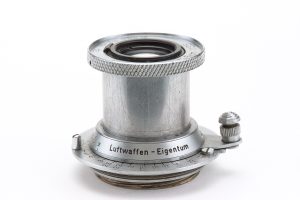
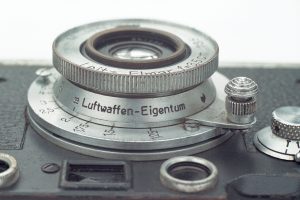
The “Luftwaffen-Eigentum” engraving wasn’t limited to camera bodies, as it appeared on lenses, cases, and other accessories as well. In many cases, a genuine Luftwaffe body might not have it’s original lens, or perhaps a genuine Luftwaffe lens might get attached to a body that it didn’t originally come with. Leitz records were kept for lenses too, so verifying lenses is also possible, but it gets more difficult with cases, viewfinders, and other things. I have to imagine however, that counterfeiters are less likely to make the effort of faking a Luftwaffe case.
With the detailed record keeping by Leitz employees back when these cameras were made, and the tremendous amount of research done by Jim Lager and other Leica historians, we have a pretty good, but not perfect resource for identifying many Luftwaffe Leica, but even with all of this great information, there is not enough information to accurately validate every single one of them out there.
We know with reasonable certainty that around 3600 were made, but how many of those survived the war is anyone’s guess. If you find a Luftwaffe Leica for sale, do your research, look up the serial numbers and make sure all of the features are correct, but most importantly, buy from someone you trust and with a little bit of luck, you’ll end up with the real thing.
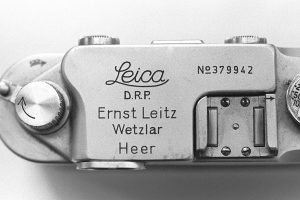
Heer Leicas
While the Luftwaffe Leicas are the most common to be found, they were not the only Wehrmacht Leicas to be shipped. The German Army or “Heer” received specialized shipments as well. Unlike the shipments to the Luftwaffe, with only one exception, the majority of Heer Leicas are not indicated as such in the Leitz ledgers of the time, so it is much more difficult to validate them.
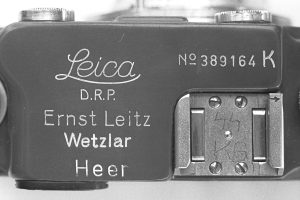
There exist Leica bodies and lenses with a Heer engraving on the top plate in the same location as the Flieger number on Luftwaffe Leicas, and in many of the known examples, the serial numbers match the same time periods in which cameras were shipped to the Luftwaffe, so there is a chance these are genuine.
The only known range of serial numbers of Heer Leicas are ones with reference to “WH” or “W.H.” (Wehrmacht Heer) in the Leitz ledger between serial numbers 391026 and 391700. These cameras were all shipped between May 1943 and December 1944. Strangely, there were at least 7 Heer Leicas prepared either May 1945 and August 1945 with a destination of the American Army suggesting Leitz continued to take orders for new cameras, even after Germany’s surrender.
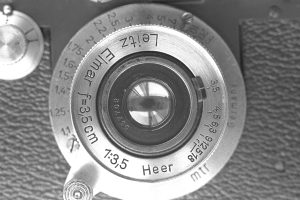
We know for sure that Heer Leicas were shipped in the range of serial numbers mentioned above, but many exist with “Heer” engravings with much lower serial numbers, the earliest of which was 350514, shipped in May 1940 suggesting that Leitz shipped Heer Leicas for nearly the same length of time as those for the Luftwaffe. But how many, and for how long? Also, why are the records so poor for these cameras? Was there a level of secrecy within the Army that didn’t exist for the Air Force? Were these shipments handled by a different employee or office who just didn’t do as good of a job? We’ll likely never know, and even worse, validating a genuine Heer Leica is nearly impossible unless it falls in the range of serial numbers from 391026 to 391700.
Kriegsmarine Leicas
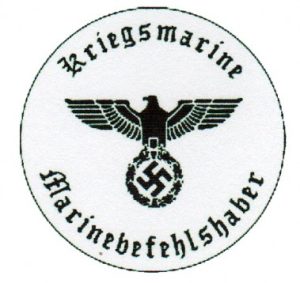
If you thought identifying Heer Leicas was hard, it’s worse for Kriegsmarine (Navy) Leicas as there is only a batch of 49 between serial numbers 384351 and 384400 shipped in March 1942 that indicate Marine use. Each of these 49 cameras are indicated with the letter “M” followed by a three digit number between 493 to 537. Beyond these entries, there are absolutely no other official indications of Kriegsmarine Leicas.
Of course, more than these have shown up over the years with similar markings of the letter “M” followed by three numbers. In addition, many of these bodies and lenses have a Reichsadler (eagle) and swastika insignia engraved somewhere into the metal. Unlike markings seen on Luftwaffe or Heer Leicas, there is a great deal of variance in the quality of these engravings. Some are very precise and neatly done, and others are done very crudely with what looked to be a pocket knife.
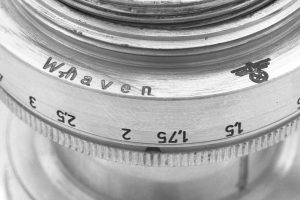
A large number of so called Kriegsmarine Leicas have been found with a “W.haven” engraving which most definitely refers to the town of Wilhelmshaven which was a major naval port for the German Navy on the North Sea.
It’s likely that some of the cameras with these inscriptions are probably real, but positively identifying them is impossible and unless additional, as of yet undiscovered documentation someday shows up, there will never be a way to positively confirm the identify of a camera or lens with one of these markings.
Re. Leica
Although not technically Wehrmacht Leicas, there exists a small number of wartime Leicas with an engraving of the abbreviation “Re.” followed by 6 numbers, which is believed to stand for “Reichssicherbeitshauptamt” which translates to “The Central Security Department of the Reich”. This was a special government agency created by Heinrich Himmler to “fight all enemies of the Reich inside and outside the borders of Nazi Germany”.
In addition to the “Re.” bodies, other Leica accessories such as lenses, viewfinders, and at least one Leica-Motor have turned up with similar “Re.” markings suggesting that at least a few special orders were fulfilled for whatever this office chose to do with them.
Kriegsberichter and Waffen Amt Leicas
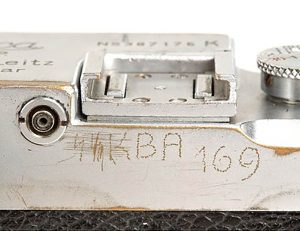
A few other interesting marks have been found on wartime Leicas, likely done by other official entities working in Nazi Germany. One such marking is a “KB” or “KBA” marking which is an abbreviation for for Kriegsberichter, which means “War Correspondent” and “War Correspondent Office” respectively. Another is the “WaA” marking which refers to an ordinance office responsible for inspection and quality control of military equipment.
Each example of KB, KBA, or WaA markings are all very crude, likely scraped into various parts of cameras, lenses, and cases by hand. These cameras likely weren’t even specially ordered through a Leitz agent, and were likely just acquired through “regular” means and engraved by office employees themselves, much like how a photo copier or computer tower in an office building might get stamped with some type of inventory control label.
As there is no official record of these ever existing, any Leitz products with these types of engravings should not be considered Wehrmacht Leicas, and simply regular wartime Leicas that were engraved by certain government agencies.
Besatzung Leicas
Unlike every previous wartime Leica mentioned here, this article wouldn’t be complete without mention of Besatzung or “Occupation” Leicas. These were regular, unmarked Leica IIIc models (and in two cases Leica IIId models) that were delivered to Allied Expeditionary forces.
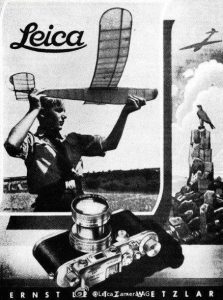
With the unconditional surrender of Germany in May 1945, it’s likely that each of the Leica cameras shipped to Allied forces during this period were all kept as souvenirs which suggests that many still survive to this day. There have been many examples of wartime Leicas acquired through various means by American and other Allied servicemen and passed down through the generations. If you have a relative who has an old Leica in the closet and he or she insists this camera was a souvenir by some distant grandfather or great-grandfather during World War II, there’s at least a good chance their story is correct, you’ll just have a really difficult time proving it!

Leica IIIb #346625
Coming back to the camera that inspired this whole article, upon receiving preliminary confirmation from Jim Lager that the “military Leica” that Joe Prah had contacted me about was likely real, Jim asked if I could get more pictures of it. I responded back to Joe asking if he would mind sending the camera to me for further research. I realized it was quite a leap of faith for some reader to send me something that likely had a lot of value but thankfully, Joe was a trusting guy and he packaged up the camera and sent it to me.
Upon receipt of the camera, I took a large number of pictures of the camera, it’s case, the Summitar lens attached to it and sent them to Jim. Within hours of my email, Jim excitedly responded confirming that what I had was a very nice looking Leica IIIb that according to his records, was sent in one of the largest single shipments of Luftwaffe Leicas to Berlin on February 26, 1940. The comment for this batch indicated code word “LEYOO Luftw.” which means it would have come with an Elmar 5cm f/3.5 lens, so the lens attached to Joe’s camera was not original to this body. Although not original to the camera, the Summitar lens is of Luftwaffe vintage and was shipped later, in October, 1940 on shipment 19148.
The camera was in fantastic cosmetic condition with all of the Luftwaffe markings in tact, but sadly the shutter was inoperable. Normally I have a strong desire to shoot every vintage camera that comes my way, but I don’t even know that if this one was working, if I would have risked taking the camera out into the great wide open and shot with it. After my photography session, I took it back home and put it back safely into it’s box and got it ready to go back to it’s owner.
I took well over 50 pictures of the camera, and rather than bore you to death with my narration of how the camera works, you probably just want to see pics (and I don’t blame you). So here is a gallery of two dozen high resolution pics. As always, click the images to open the gallery and if you like, download the full 3000×2000 pixel images for yourself!
Leica IIIb #346625 was easy to identify as a genuine Luftwaffe Leica not just because the serial number matched a known batch of cameras shipped to the Luftwaffe in February 1940, but it was in such good condition, the rest of the provenance was easy to prove.
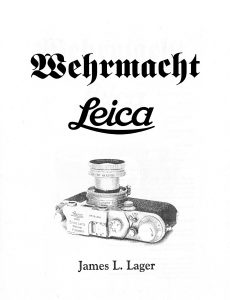
Sadly, this isn’t always the case. As I mentioned earlier, there are fakes out there. Most are easy to spot, but not all of them. As the years go by and the stories and legends of wartime cameras grows, more and more cameras will likely be faked. If you come across one, how do you confirm it’s the real thing. My best recommendation is to ask an expert. If you can get a copy of “Wehrmacht Leica” I highly recommend it as it has a great deal of excellent information. Do your research, ask questions, and only pay a premium for it if it can be proved.
Special Thanks
I would not have even attempted an article like this had it not been for Joe Prah, who had enough trust to contact me and send me his wonderful Luftwaffe Leica. No one will ever know how many of these cameras survived the war and still exist to this day. Fewer still are in such great shape and come with a correct lens, case, and filter. I won’t even speculate what the value of this camera is today, but Joe was gracious enough to loan it to me for the purposes of this article.
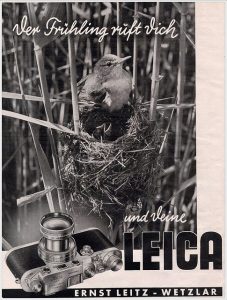
With only the camera, all I would have had were some pretty pictures of an old Leica, so I have to give additional thanks to Jim Lager, Leica historian, member of the Leica Historical Society, and author of the Wehrmacht Leica book to which most of my research was taken. In addition to simply sending me a copy of his book, Jim also took the time to answer countless emails and questions, even providing me with the original JPGs used in the creation of his book. I made sure Jim was happy with the content of this article before publishing it, because it was very important to me that I get it right.
Although his “Wehrmacht Leica” book is out of print, you can find Jim’s other works, including the massive three volume set “Leica: An Illustrated History” on Amazon.
If you would like to know more about Leica’s history and read more of Jim Lager’s work online, he is an active member of the Leica Historical Society which is open for membership to anyone interested. Please consider visiting their page and joining in their discussion.

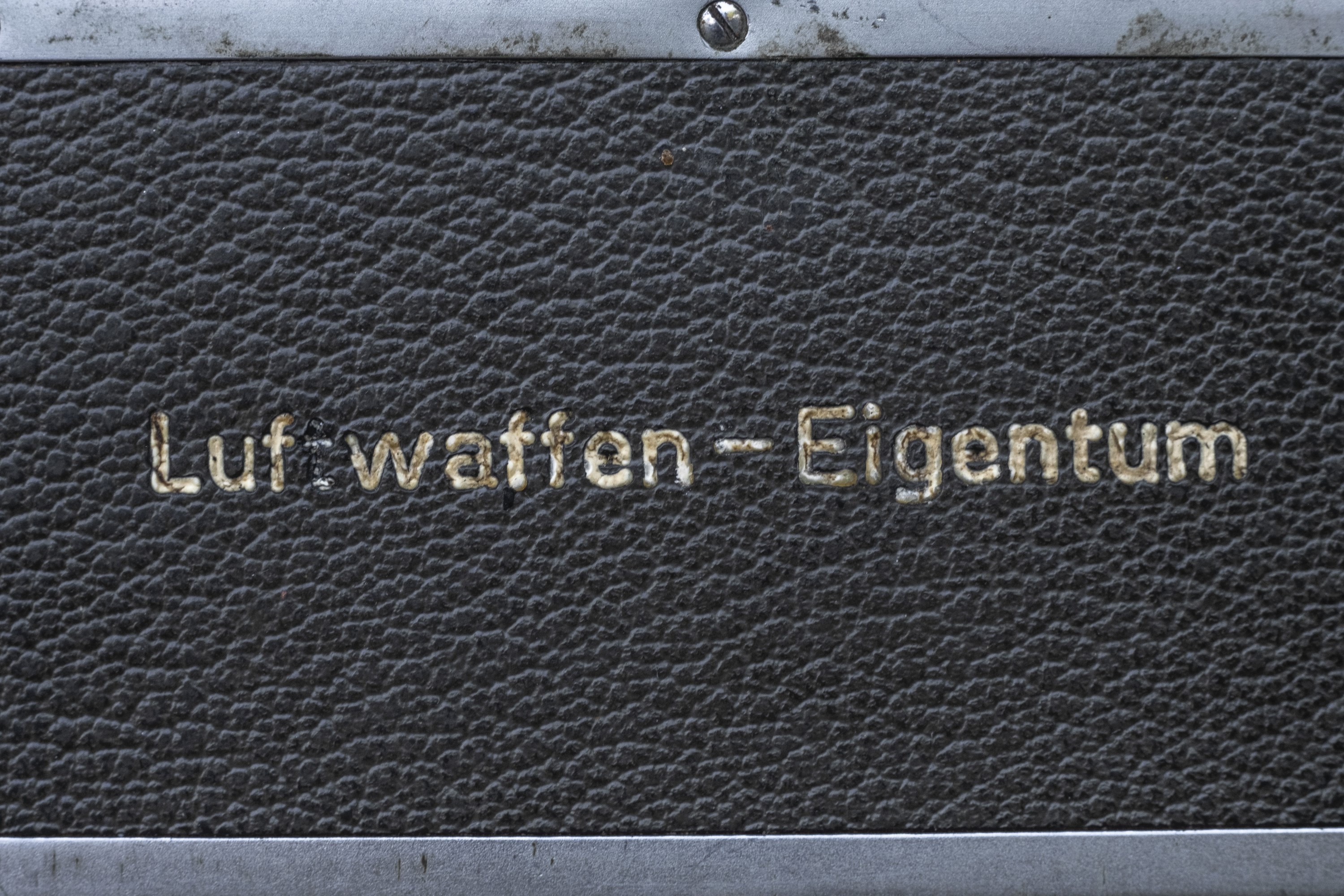
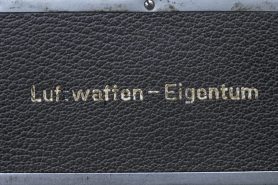






























Very goog an article! Thank You very much.
Very nice. Well written. I am a big Leica fan and enjoy every bit of history about the company. Thank you.
Mike, thanks, this is a Keeper!
I am a big long time lover of Leica screwmounts. I have most of Jim Larger’s books. I didn’t know they were worth so much. Another very interesting article Mike. Keep up the good work.
Just to remind you Americans(&British) that war crimes were committed on all sides, it not a ‘nazi’ German novelty. Was it not a war crime to bomb German & Japanese civilian population, example? But history is written by victors, almost always. Regardless of pure facts. Otherwise, keep up good work.
As always, you have been very thorough in undertaking the research to back up this well-written, meticulously illustrated and fact-filled article.
My father purchased a IIIc at a PX in Okinawa where he was stationed during the Korean unpleasantness, non-combatant role (dentist). I shot that camera in the early 1970s in high school photography classes. It worked fine then but another forty years has come and it is time for a CLA to be done. It came with a 50mm f2 Summicron, and a couple of “Nippon Kogaku” (Nikon) produced lenses with lens cap interiors that said “Made in Occupied Japan.” Bit of history there too.
Any suggestions on who might be able? Thank you for this interesting article.
Nice article. My 1939 Leica IIIa has an asterisk after the serial number. What does it mean? And finally, the name Heinrich Hoffmann (Hitler’s personal photographer and good friend) is engraved in the bottom plate along with the letters N.S.D.A.P. Which stands for Nationalist German Party or Nazi. Is it real or fake?
The german word for ball bearing is “Kugellager”, spelled with two L.
Outside of Jim Lager’s book, this page is like a one-stop shop for what one needs to know about military Leica’s. Thanks for the details!
Thanks for the compliments Johnny. Yes, Jim’s book is an invaluable resource, and there’s no way I could have completed this article without it!
Thanks for this enlightening article, which taught me how Leica helped so many oppressed people escape the Nazis.
Some informations you have found are not reliable. Moreover: there are many more things to know. If you realy are interested in those years/production I know that there is an Italian researcher that wrote dozen of articles about this matter (he researched especially this topic for about 35 years, also interviewing many WWII photoreporters. He actually has a huge archive). AFAIK Jim Lager knows him, so you can ask contact info to him if you need.
Philippe, thanks for the info. I agree with you that this article does not cover every single facet of Wehrmacht Leicas, rather it’s a summary of the known facts from Jim’s book. He proofread and signed off on the entire article before I published it, so I am pretty confident in the information I have. If there is something you think I should add, feel free to add it to the comments.
I read a modern fictional thriller entitled The Huntress, in which an American teenager in 1946 had been using a Leica. Her father was antiques dealer so maybe this was possible but not plausible. Do you have any comments on this?
The first Leica cameras went on sale in 1925 and were very popular in the United States before and during WWII, so it’s very likely that many Americans in 1946 used Leicas. The only thing that might be implausible is that most teenagers back then would have not been able to afford a Leica as they were quite expensive, but that doesn’t mean he or she couldn’t have borrowed one.
Excellent article, well done establishing the provenance of Mr Prah’s camera !
I noticed two typos:
Reichssicherbeitshauptamt;
occuption.
best wishes!
Really nice article.
I do find it funny thought, that when Leica send [Leica IIIb #346625] to the German army (which was fighting for world domination), Leica still put a warning label on the baseplate, not only in German, but also in English, French and Italian.
I was in the U. S. Army in Giessen, Germany in 1960-62. I bought a used rangefinder Leica in the PX. My first camera. It had a collapsable lens and a brown leather case. The interesting thing to me is the camera had a German military marking on. I’ve always been curious why the US PX would be selling it. On a trip to the Alps in ’62 I set the camera on top of my VW while looking a vistas or whatever and drove off. By the time I missed the camera it was too late to go back, two feet of packed snow and still snowing hard. I don’t remember the camera number or other identifiers but would sure like to still have it. When I look at old slides made with it I am still amazed at the quality of the pictures.
A very interesting post. You may also know that during the Second World War the British government placed adverts in the amateur and professional photographic press for individuals to donate their Leica and Contax cameras to the war effort.
Most or all of these were turned over to the RAF, I believe not for use as conventional cameras or indeed any form of photo-reconnaissance but to record test results connected with early air -ground scanning radar.
Regarding the FED I camera and the Leica( I have recently bought a lovely Leica III leather case for my FED Ig Ukrainian-made camera – not to con anyone, simply as I can’t find an authentic case for the FED!